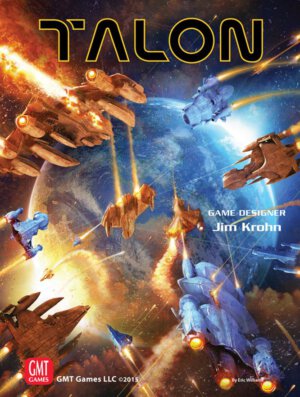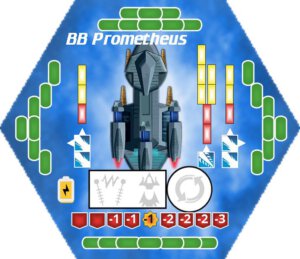
Talon is available now for an MSRP of $59.00. Look for our Outside the Box video in about a week so you can see the game up close!
From GMT:
Talon is a tactical game of space fleet combat between the Terran Confederation and the invading Talonthincanthanadu (Talon) Empire.
Space combat games have been done before. What sets this game apart?
Fleet Combat: This is a game of fleet combat. Battles with individual ships can be fought, but the game has been designed to be able to easily handle combat with fleets of 3-10 ships. The system would have to be very simple and elegant to handle that smoothly – more on that later…
Capital Ships: This is NOT a game about fighter combat in space. The ships in the game, for the most part, are large ships that have shields, have to charge systems, and maneuver – not just do an Immelman.
Simplicity: The game accurately captures the feel of science fiction space combat as seen in the major sci-fi franchises, but it does so very simply. The play test rules, including all the advanced rules, are only 8 pages long, and that includes a lot of “historical” explanations and setting of the conflict.

Power Curve: Each ship class has a specific “Power Curve”. All of the energy use for basic systems for the ship are already baked into the Power Curve. All a player has to do is adjust the speed of the ship (and there are limits up and down on how much can be adjusted), and the power curve gives the turn radius for the ship and how much additional power is available. This power can be spent as it becomes available throughout a turn to do things like: charge a weapon faster than normal, reinforce a shield, turn the ship faster than normal, etc. depending on the needs of the situation. The game represents tactical combat that is happening very quickly. This rule has each player making quick decisions on the fly as power becomes available instead of planning out a turn in great detail ahead of time.
Map not Miniatures: This decision is larger than you might think at first glance. In some ways, this game has concepts that would be right at home in a miniatures game, but I definitely wanted this to be played on a map. When dealing with firing arcs and distances moved, just a small change, bump of the card or miniature, etc. can have a dramatic impact on game play. There is a reason why games like that are sometimes umpired. With the game being hex and counter, everything is very distinct, the rules are simpler, and movement is quick. The map allows the game to be played so much faster.
Large, Laminated Counters: This is perhaps the most innovative part of the game. The counters in this game are hexagonal shaped, laminated, and very large (the hexes in the game are roughly the size of a hex in Space Empires). The largeness of the counter allows all of a ship’s systems to be displayed right on the map and the lamination allows the player to mark damage right on the counter with a dry erase marker. Being able to see everything right on the map allows the game system to handle a much larger number of ships without confusion and without a lot of effort. For those of you who are old school and do not want to write on the counters, logsheets will be provided.


















